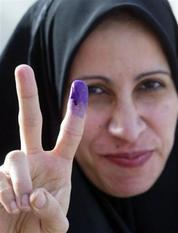The Iraq War
Iraqi Elections
January 31, 2005
On January 31st 2005 citizens of Iraq were finally able to vote on possibly a complete reformation of the government. This was a nationally and globally important election. As was President Bush’s proclamation, American troops went in with the promise to remove Saddam Hussein from government and bring about democracy to the country. If democracy could thrive in the Iraq, then it would be an excellent example for the rest of the Middle East. Iraq's Shi'a, Kurds and Sunnis, as well as a few other political parties had begun campaigning for election in the months leading up to the election. On the day of the election, seven Iraqi citizens and one international expert were put in charge of supervising the election and proceedings. This was called the Independent Electoral Commission, and stressed the rights of the Iraqi citizens in regards to political choice. It was also decided that Iraq would be considered a single constituency which was thought to provide the best representation of the people. This means that Iraq as a whole would elect the necessary legislators for the government. This differs from America’s policy in which each district votes for its own legislators and only their own. The hope was that any political faction or even independent candidate can be elected to the Assembly if he/she receives the proper amount of votes. Each political party was also allowed to submit a list of candidates. The only contingencies were that each list must be made of up of at least ¼ women and contain to members with any ties to Iraqi insurgent groups or served as a high-ranking Ba’ath official. 275 candidates are then to be by the people to the transitional National Assembly. The National Assembly job was to create a constitution that would be put out for a public referendum. Then in October 2005 the constitution would be passed if the public votes on it. It would also serve as the national legislature and, through its Presidential Council, appoint a Prime Minister. However, in the midst of the election, national security was a huge threat in Iraq. Prior to the election, election officials were dragged out of their cars and killed by Iraqi insurgents. Many death threats were made to other officials as well as to poling centers and candidates. Iraqi forces were called in to maintain control over the election and protect the citizens voting. However there were major doubts as to whether there were enough troops to provide enough protection. Regardless of government forces offering protection, many boycotts of the elections were held. Most of the boycotters included Arab Sunnis, who, according to polls, had only a 2% turnout at the election. Other problems soon arose including voter education and national parties. Of all the remaining Iraqi political parties, there was almost no party that transcended ethnic or sectarian differences; which was needed if Iraq was truly going to become a democratic country. As for the voters most did not understand political policy or even words such as constituency, due to a lack of education. However groups such as the Civil Dialogue Organization where called in to help educate the citizens. Despite all the problems and turmoil leading up to and during the day of the election, it was not postponed and 275 members were elected to the National Assembly. In the end, Iraq was able to get an initial head-way into creating a more democratic government.


